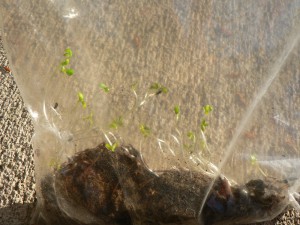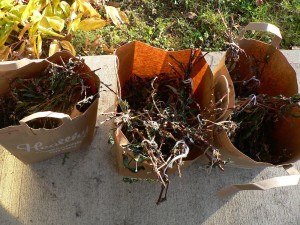About a month ago I was tidying up the crafts room. I was trying to get organized so I could weave a new crop of “Jack Frost” bookmarks before the winter holidays.
The crafts room is the room in our apartment which houses my loom, all my yarns, dried dye plants, dye equipment and materials, niddy noddy, swift, scales, carders, and drop spindles. It also contains two large book shelves full of books, a desk, a small filing cabinet, bookbinding supplies and tools, two antique scutching knives and an antique hetchel. The crafts room also contains a lot of dyed fleece and spinning fiber, hand-woven items, notebooks with all my dyeing, weaving, and teaching records, and some fiber magazines. Also, it’s where I store plastic bins with samples and materials for various fiber arts activities that I teach, and an ironing board and iron. And lots of other stuff like dye plant seeds and the beater and reeds for a 40 inch Macomber loom that’s been occupying my mom’s laundry room for a year while I try to figure out what to do with it. I know, that is a nutty list, and I didn’t even list everything. It is in a fairly chronic state of chaos.
There’s no flax in there, though. That’s all stored in the bedroom and the minivan. The spinning wheel lives in the living room.
Far more occasionally than I’d like, I wrestle the crafts room into a momentary state of order in which I can actually weave. This was one of those rare occasions. So, as I said, I was doing some tidying. I came across a zip-lock bag with soil inside, and to my surprise there were tiny little green sprouts growing inside.
I was briefly confused. Then I remembered that I had collected some Japanese indigo seeds that had fallen on the ground when I was cutting all the plants for harvest in October. I just scooped up the seeds and the soil they were resting on and dumped them in a bag. After I got home that day, I was focused on tying up the plants and setting them up to dry. In the meanwhile I forgot about these seeds in the zip-lock. I didn’t expect that they could germinate in a bag. But clearly, the soil was moist enough for them to germinate, and they must not need a lot of light or scarification or cold stratification or anything fancy. Here’s a close-up:
They were spindly and doomed, since it was November and we don’t have a greenhouse or any natural light in the apartment. But they grew! I was very excited. This bodes well for growing a large crop next year, and sharing seeds with others once I get them cleaned up.
Apparently I never took a photo of the Japanese indigo plants hung up to dry. That’s a shame because it was pretty impressive. When they were fresh they were very bulky. The plant material entirely filled our downstairs half-bath.
The plants dried very nicely in that little room with the heat on at 75 degrees. They even retained the vivid color of the flowers, the magenta stems, and some of the dark green of the leaves.
As the dried, they shrank in size considerably. This is good because I don’t have that much storage space. The bags of dried plant material are currently stored in, you guessed it, the crafts room.
Many seeds fell off while the plants dried and I collected them on paper spread out on the floor. Many are still clinging inside the dried flower clusters, on the plant stalks. There’s a chance I can use the dried leaves for dyeing when the warm weather returns. Meanwhile, here are the three paper grocery bags full of dried Japanese indigo plants and seeds:
Three bags full. I have yet to strip off the leaves or separate the seeds. This will no doubt be a messy and time-consuming job, resulting in a very small quantity of end product. My specialty.




